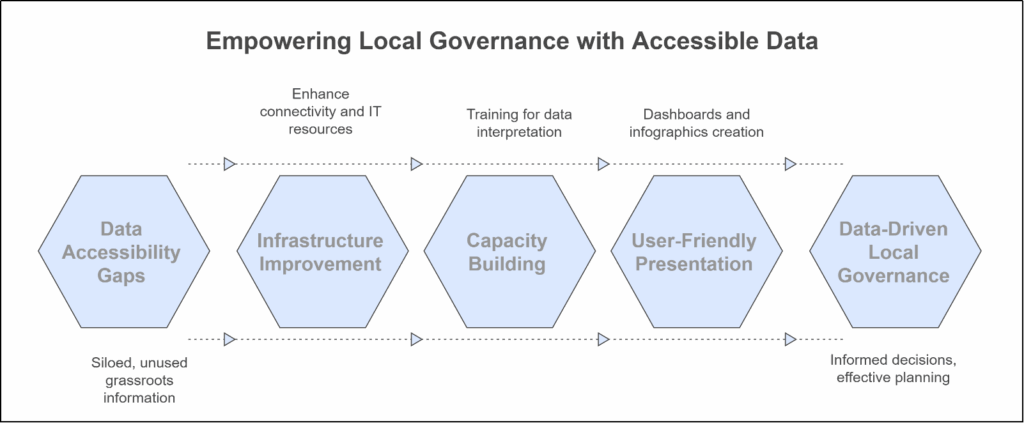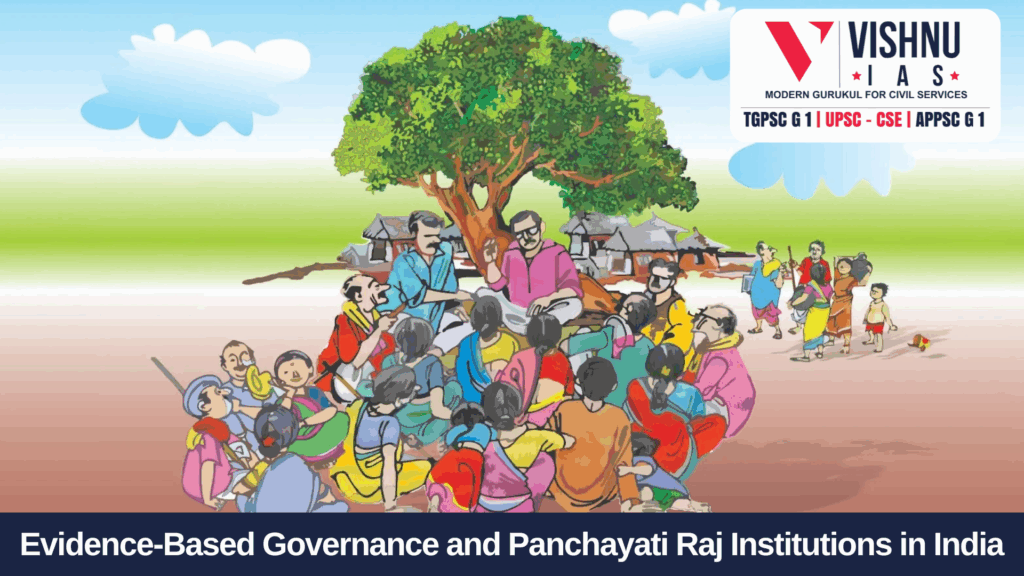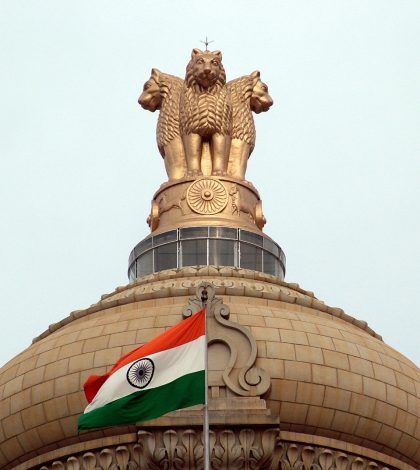Evidence-Based Governance and Panchayati Raj Institutions in India
Introduction
Evidence-based decision-making has emerged as a cornerstone of good governance, emphasizing data-driven approaches to ensure transparency, accountability, and effective policy implementation. At the grassroots level, Panchayati Raj Institutions (PRIs) play a vital role in local governance, and leveraging data can help address development gaps, allocate resources effectively, and promote sustainable growth. Several initiatives, such as the NITI Aayog’s SDG India Index, the National Data Sharing and Accessibility Policy (NDSAP) of 2012, and the Panchayat Devolution Index (PDI), highlight the government’s focus on data-driven governance for PRIs. However, significant challenges remain in translating these policy frameworks into actionable strategies at the village level.
Challenges in Data Accessibility and Use

While policy-level initiatives stress the importance of open data and analytics, grassroots-level implementation faces numerous obstacles:
• Fragmented and Inaccessible Data:
- Although vast amounts of data are generated at the grassroots level through census surveys, scheme reports, and departmental databases, much of this information remains siloed. Online portals like data.gov.in provide access to national datasets, but these platforms are often designed for higher-level officials and researchers, not for local-level stakeholders.
• Technological and Infrastructure Gaps:
- Limited internet connectivity, inadequate IT infrastructure, and lack of technical training among Panchayat officials hinder effective data access and use. Many Panchayats operate in resource-constrained environments, which restricts their ability to engage with digital tools.
• Low Data Literacy:
- Elected representatives and Gram Sabha members often lack the skills to interpret and utilize data for planning. Even when data is available, it is not presented in user-friendly formats such as dashboards or infographics, making it challenging for local leaders to derive actionable insights.
• Uneven Capacity Building:
- States like Kerala have successfully localized SDG planning by training local officials and developing real-time dashboards. However, many states lack similar initiatives, leading to uneven capacity and reliance on anecdotal decision-making.
The Panchayat Advancement Index (PAI)
The Ministry of Panchayati Raj introduced the Panchayat Advancement Index (PAI) in April 2025 as a comprehensive tool to empower PRIs with actionable data. The PAI framework:
• Scope and Indicators:
- The PAI covers over 255,000 Gram Panchayats nationwide and evaluates them across nine themes aligned with the Sustainable Development Goals (SDGs), including poverty eradication, health, water sufficiency, education, social justice, and governance. A total of 435 unique local indicators (331 mandatory and 104 optional) are used to assess Panchayat performance.
• Grading System:
- Panchayats are graded from A+ (Achievers) to D (Beginners), enabling local governments to identify development gaps. For instance, a village scoring poorly on the health theme can prioritize interventions in maternal health or sanitation.
• User-Friendly Portal:
- The PAI portal (pai.gov.in) provides Panchayat scores in an accessible format, allowing even sarpanches and ward members to understand their village’s performance and plan accordingly.
• Integration with SDG Localization:
- By aligning with the National Indicator Framework (NIF) for SDGs, the PAI bridges the gap between global goals and local governance. It provides a standardized framework for evaluating and improving Panchayat performance.
Case Study: Kerala’s SDG Localization Model
Kerala serves as a model for effective data-driven governance at the Panchayat level:
• Real-Time Dashboards:
- Kerala’s Local Self-Government Department has developed real-time SDG dashboards, allowing officials and citizens to track progress on key indicators such as water and sanitation.
• Community Engagement:
- Awareness campaigns and training programs ensure that Gram Sabha members and local communities actively participate in planning processes. For instance, school students and youth federations contribute to reporting developmental issues.
• Integration with Schemes:
- Panchayats align their development plans with national and state schemes, such as Mission Antyodaya and the Jal Jeevan Mission, ensuring that resources are directed where they are most needed.
Kerala’s success demonstrates the transformative potential of empowering PRIs with relevant data and capacity-building initiatives. The PAI framework can help replicate this model in other states.
Data Validation and Coverage Issues
While the PAI is a promising initiative, challenges in data validation and coverage need to be addressed:
• Validation Gaps:
- Of the 255,699 Gram Panchayats nationwide, only about 216,285 (85%) submitted validated data for the PAI. States like Uttar Pradesh validated data for just 40% of their Panchayats, leaving large portions unassessed.
• Incomplete Coverage:
- Many regions remain excluded from the PAI due to unvalidated or missing data. This compromises the index’s credibility and limits its utility in identifying and addressing development gaps.
• Reliability of Data:
- Ensuring the accuracy of data is critical for the PAI’s success. This requires standardizing data collection methods and involving third-party agencies for independent validation.
Engaging Stakeholders in Data Use
To make evidence-based governance a reality at the grassroots level, active stakeholder engagement is essential:
• Training and Awareness:
- Dedicated training programs can enhance the data literacy of Panchayat officials and elected representatives. Institutions like the State Institutes of Rural Development (SIRDs) and civil society organizations can play a key role in building capacity.
• Civil Society Participation:
- NGOs and academic institutions can serve as knowledge partners, assisting Panchayats in interpreting PAI scores and developing actionable plans.
• Role of Legislators:
- Members of Parliament and State Legislatures can use PAI-generated reports to monitor local needs and allocate funds effectively through schemes like MPLADS and MLALAD.
• Institutional Integration:
- Line departments (health, education, water) should integrate PAI data into their planning processes. For example, a low score on the health theme can prompt targeted interventions in underperforming areas.
Policy Recommendations
To strengthen the data ecosystem for PRIs and maximize the impact of initiatives like the PAI, the following measures are recommended:
• Capacity Building:
- Launch targeted training programs on data literacy and analytics for Panchayat officials, elected representatives, and community leaders.
• Data Analysts at Local Levels:
- Appoint dedicated data analysts at the block and district levels to collect, clean, and analyze Panchayat data, ensuring its integration into decision-making processes.
• Infrastructure Development:
- Accelerate the rollout of high-speed internet and provide basic computing facilities at all Panchayat offices. Develop user-friendly local language portals to enhance accessibility.
• Validation Mechanisms:
- Implement third-party or community-led data validation to improve the reliability of the PAI. Engaging local NGOs or academic institutions can ensure the accuracy of key indicators.
• Stakeholder Forums:
- Establish district-level multi-stakeholder forums to periodically review Panchayat performance and discuss PAI scores with elected representatives, officials, and civil society organizations.
• Incentivizing Performance:
- Link part of performance grants or awards to improvements in PAI scores to encourage data-driven governance.
Conclusion
Evidence-based governance at the grassroots is essential for achieving inclusive and sustainable development. The Panchayat Advancement Index represents a significant step toward empowering PRIs with actionable data and aligning local priorities with national and global goals. However, realizing its full potential requires addressing challenges in data accessibility, validation, and stakeholder engagement.
Kerala’s SDG localization model provides valuable lessons on the importance of community involvement, real-time monitoring, and institutional integration. By implementing the recommended policy measures, India can ensure that its Panchayati Raj Institutions become engines of evidence-based decision-making and effective governance, paving the way for a more equitable and prosperous society.


